
A planetary nebula is a type of emission nebula consisting of an expanding, glowing shell of ionized gas ejected from red giant stars late in their lives.

The Orion Nebula is a diffuse nebula situated in the Milky Way, being south of Orion's Belt in the constellation of Orion, and is known as the middle "star" in the "sword" of Orion. It is one of the brightest nebulae and is visible to the naked eye in the night sky with apparent magnitude 4.0. It is 1,344 ± 20 light-years (412.1 ± 6.1 pc) away and is the closest region of massive star formation to Earth. The M42 nebula is estimated to be 24 light-years across. It has a mass of about 2,000 times that of the Sun. Older texts frequently refer to the Orion Nebula as the Great Nebula in Orion or the Great Orion Nebula.

The Cat's Eye Nebula is a planetary nebula in the northern constellation of Draco, discovered by William Herschel on February 15, 1786. It was the first planetary nebula whose spectrum was investigated by the English amateur astronomer William Huggins, demonstrating that planetary nebulae were gaseous and not stellar in nature. Structurally, the object has had high-resolution images by the Hubble Space Telescope revealing knots, jets, bubbles and complex arcs, being illuminated by the central hot planetary nebula nucleus (PNN). It is a well-studied object that has been observed from radio to X-ray wavelengths.

The Calabash Nebula, also known as the Rotten Egg Nebula or by its technical name OH 231.84 +4.22, is a protoplanetary nebula (PPN) 1.4 light years long and located some 5,000 light years from Earth in the constellation Puppis. The name "Calabash Nebula" was first proposed in 1989 in an early paper on its expected nebular dynamics, based on the nebula's appearance. The Calabash is almost certainly a member of the open cluster Messier 46, as it has the same distance, radial velocity, and proper motion. The central star is QX Puppis, a binary composed of a very cool Mira variable and an A-type main-sequence star.

The Eskimo Nebula, also known as the Clown-faced Nebula, Lion Nebula, or Caldwell 39, is a bipolar double-shell planetary nebula (PN). It was discovered by astronomer William Herschel in 1787. The formation resembles a person's head surrounded by a parka hood. It is surrounded by gas that composed the outer layers of a Sun-like star. The visible inner filaments are ejected by a strong wind of particles from the central star. The outer disk contains unusual, light-year-long filaments.

The Stingray Nebula is the youngest-known planetary nebula, having appeared in the 1980s. The nebula is located in the direction of the southern constellation Ara, and is located 18,000 light-years away. Although it is some 130 times the size of the Solar System, the Stingray Nebula is only about one tenth the size of most other known planetary nebulae. The central star of the nebula is the fast-evolving star SAO 244567. Until the early 1970s, it was observed on Earth as a preplanetary nebula in which the gas had not yet become hot and ionized.

IC 418, also known as the Spirograph Nebula, is a planetary nebula located in the constellation of Lepus about 3,600 ly away from Earth. It spans 0.3 light-years across. The central star of the planetary nebula, HD 35914, is an O-type star with a spectral type of O7fp. The nebula formed a few thousand years ago during the stars last stages of its red giant phase. Material from the star’s outer layers was ejected from the star into the surrounding space. The nebula’s glow is caused by the central star’s ultraviolet radiation interacting with the gas.

T Tauri is a variable star in the constellation Taurus, the prototype of the T Tauri stars. It was discovered in October 1852 by John Russell Hind. T Tauri appears from Earth amongst the Hyades cluster, not far from ε Tauri, but it is actually 420 light-years behind it and not a member of the cluster. The cloud to the west of the system is NGC 1555, known more commonly as Hind's Variable Nebula.
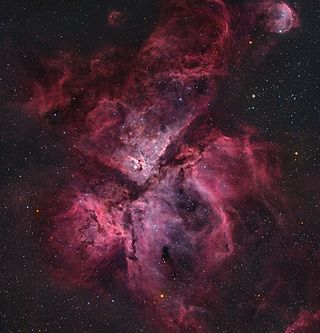
The Carina Nebula or Eta Carinae Nebula is a large, complex area of bright and dark nebulosity in the constellation Carina, located in the Carina–Sagittarius Arm of the Milky Way galaxy. The nebula is approximately 8,500 light-years (2,600 pc) from Earth.

The Crescent Nebula is an emission nebula in the constellation Cygnus, about 5000 light-years away from Earth. It was discovered by William Herschel in 1792. It is formed by the fast stellar wind from the Wolf-Rayet star WR 136 colliding with and energizing the slower moving wind ejected by the star when it became a red giant around 250,000 to 400,000 years ago. The result of the collision is a shell and two shock waves, one moving outward and one moving inward. The inward moving shock wave heats the stellar wind to X-ray-emitting temperatures.

The Homunculus Nebula is a bipolar emission and reflection nebula surrounding the massive star system Eta Carinae, about 7,500 light-years from Earth. The nebula is embedded within the much larger Carina Nebula, a large star-forming H II region. From the Latin homunculus meaning Little Man, the nebula consists of gas which was ejected from Eta Carinae during the Great Eruption, which occurred ~7,500 years before it was observed on Earth, from 1838 to 1845. It also contains dust which absorbs much of the light from the extremely luminous central stellar system and re-radiates it as infra-red (IR). It is the brightest object in the sky at mid-IR wavelengths.
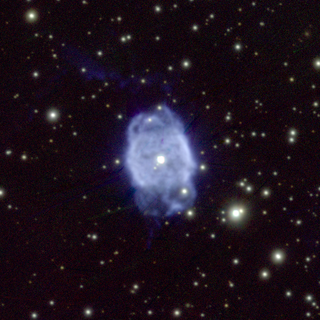
NGC 40 is a planetary nebula discovered by William Herschel on November 25, 1788, and is composed of hot gas around a dying star. The star has ejected its outer layer which has left behind a small, hot star. Radiation from the star causes the shed outer layer to heat to about 10,000 degrees Celsius and become visible as a planetary nebula. The nebula is about one light-year across. About 30,000 years from now, scientists theorize that NGC 40 will fade away, leaving only a white dwarf star approximately the size of Earth.

The formation of the Solar System began about 4.6 billion years ago with the gravitational collapse of a small part of a giant molecular cloud. Most of the collapsing mass collected in the center, forming the Sun, while the rest flattened into a protoplanetary disk out of which the planets, moons, asteroids, and other small Solar System bodies formed.

HH 46/47 is a complex of Herbig–Haro objects, located around 450 parsecs away in a Bok globule near the Gum nebula. Jets of partially ionized gas emerging from a young star produce visible shocks upon impact with the ambient medium. Discovered in 1977, it is one of the most studied HH objects and the first jet to be associated with young stars was found in HH 46/47. Four emission nebulae, HH 46, HH 47A, HH 47C and HH 47D and a jet, HH 47B, have been identified in the complex. It also contains a mostly unipolar molecular outflow, and two large bow shocks on opposite sides of the source star. The overall size of the complex is about 3 parsecs.
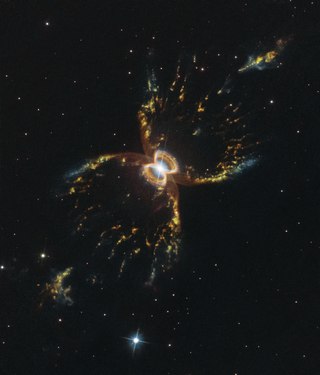
The Southern Crab Nebula is a nebula in the constellation Centaurus. The nebula is several thousand light years from Earth, and its central star is a symbiotic Mira variable - white dwarf pair. It is named for its resemblance to the Crab Nebula, which is in the northern sky.

The Becklin–Neugebauer Object(BN) is an object visible only in the infrared in the Orion molecular cloud 1 (OMC1). It was discovered in 1967 by Eric Becklin and Gerry Neugebauer during their near-infrared survey of the Orion Nebula. A faint glow around the center-most stars can be observed in the visible light spectrum, especially with the aid of a telescope.

Westbrook Nebula is a bipolar protoplanetary nebula which is located in the constellation Auriga. It is being formed by a star that has passed through the red giant phase and has ceased nuclear fusion at its core. This star is concealed at the center of the nebula, and is ejecting gas and dust at velocities of up to 200 km/s. The nebula is named after William E. Westbrook, who died in 1975.
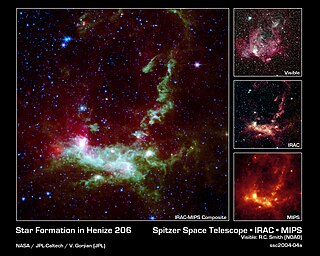
Henize 206 is a nebula in the Large Magellanic Cloud. This luminous cloud of gas and dust houses a cluster of newborn stars. Although Henize 206 was first catalogued in the 1950s, it was reported in NASA press releases in March 2004, for showing several example images generated from the various infrared cameras on the Spitzer Space Telescope launched in August 2003.
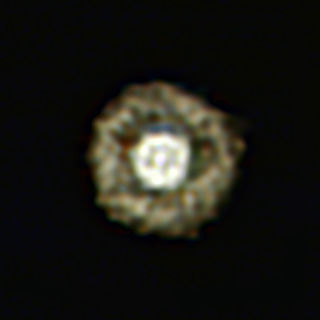
IRAS 17163−3907, also known as Hen 3-1379, is a yellow hypergiant star located 13,000 light years from Earth in the constellation of Scorpius. The star is embedded in thick shells of expelled gases and dust, and owing to its appearance has been nicknamed by astronomers the "Fried Egg Nebula". Yellow hypergiants are in an extremely active phase of their evolution.

Hen 2-437 is a bipolar planetary nebula in the constellation Vulpecula. The nebula is notable for its ice blue colorisation. It was first discovered by Rudolph Minkowski in 1946. Hen 2-437 formed when a low mass star similar to our sun swelled into its red giant phase ejecting its outer layers into space.




















